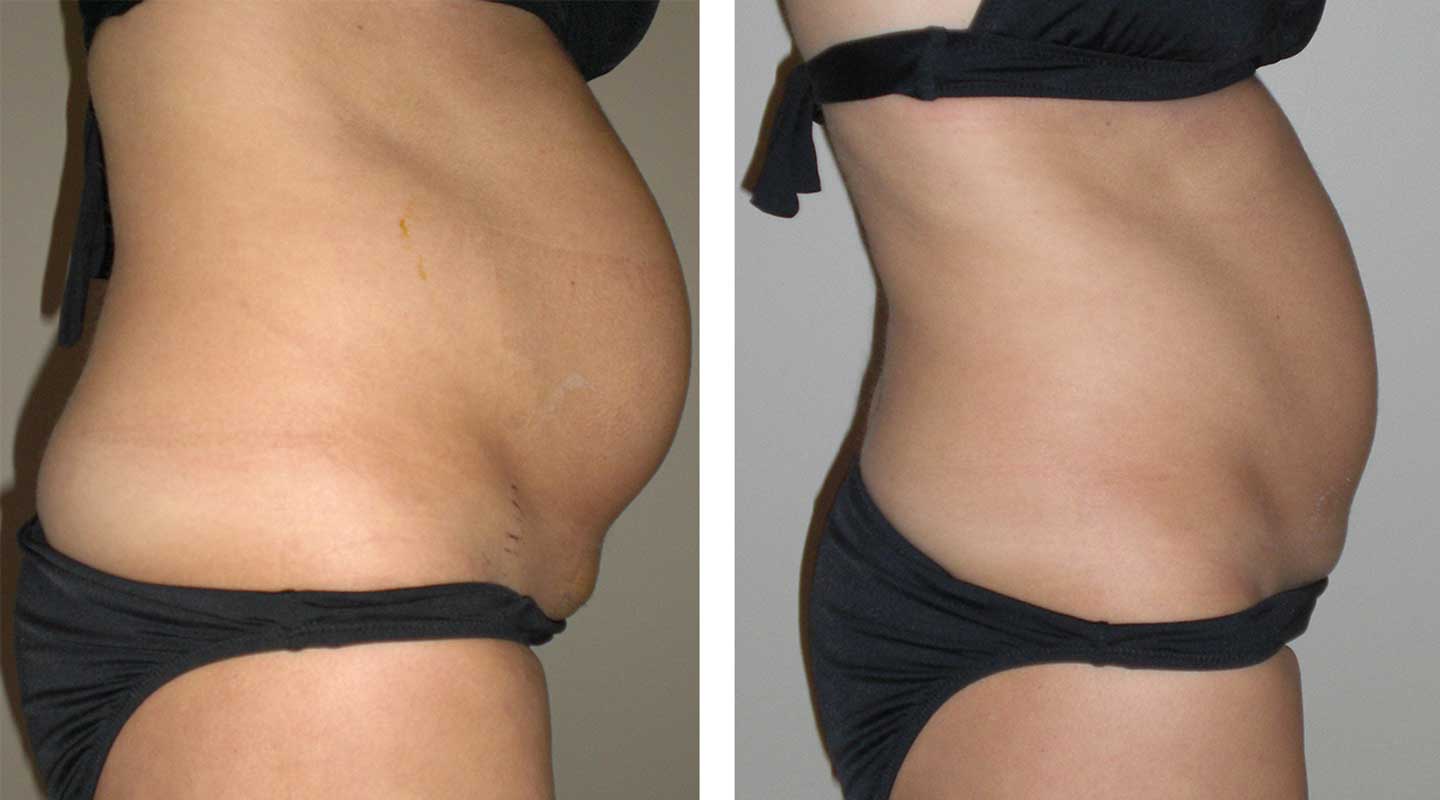
You might be surprised to find that your baby belly lingers for weeks to months, after giving birth. But remember — your body just spent nine months creating a home for your baby, and now your muscles and skin need time to adjust to this major change.
Recovery after a C-section requires a little extra care compared to a vaginal delivery, but it’s not catastrophic — not at all. With the right support, you can rebuild your strength safely and confidently. Our Moms Into Fitness Postnatal Exercise Program is designed to guide you through this healing process. Before you jump in, there are a few important things you should know…
When Can I Start Exercising After a C-Section?
The first few weeks after birth are a delicate time, both physically and emotionally. Sleep deprivation and surgery recovery can make healing feel overwhelming, so give yourself grace.
Typically, around four to six weeks postpartum, your body is considered “normal” again in terms of system function — blood volume, diaphragm position, and uterus size return to pre-pregnancy states. However, you’ll still notice signs of recovery: loose muscles, fluid retention (especially for breastfeeding), extra fat stores, things are a little different than before.
Much of your initial weight loss comes from the loss of amniotic fluid, the placenta, blood volume, and swelling. But recovering from major surgery — and the effects of pregnancy — takes time and care.
Exercising after a C-section should start cautiously. With your healthcare provider’s clearance, you can begin gentle pelvic floor exercises (like Kegels) within days after delivery. Pregnancy affects pelvic floor strength, making pelvic floor work crucial — even after a C-section. A study published in the American Journal of Obstetrics and Gynecology found that moms who’d had a C-section were less likely to do pelvic floor exercises, but pregnancy itself affects the pelvic floor, so pelvic floor exercises are a must for every mom.
Download our Prenatal & Postnatal Exercise Guide for step-by-step pelvic floor instructions.
After you’re cleared for full exercise, usually around the 6–8 week mark, you can start with foundational core exercises to rebuild stability and protect the incision site. Movements should be pain-free — if anything feels uncomfortable, back off and give your body more time.
Smart fitness for moms in any stage: bump, new baby, and beyond.
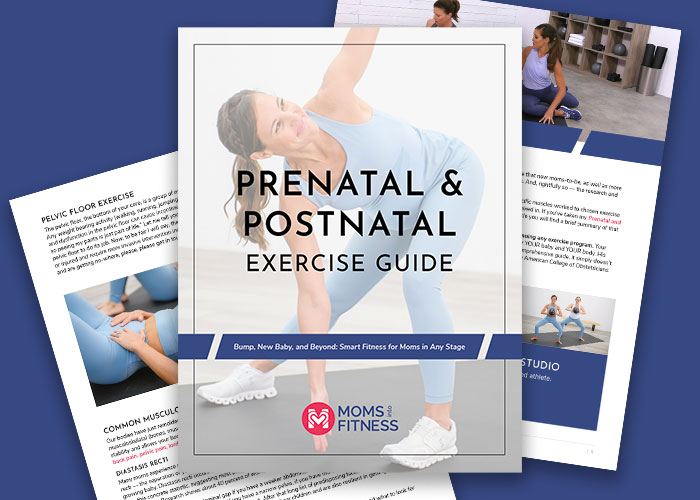
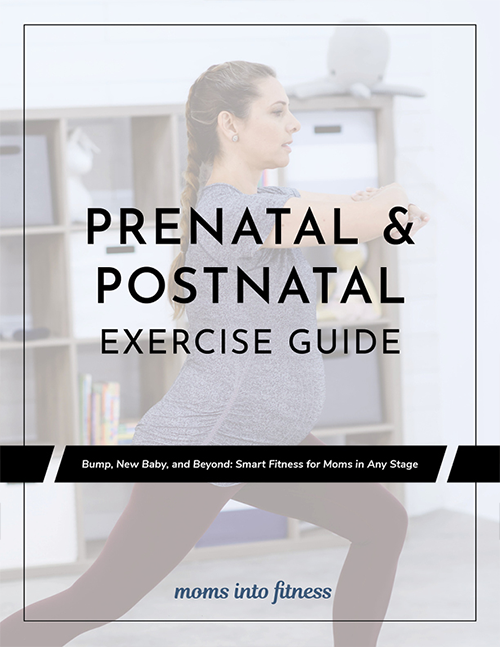
It’s important to manage your expectations when it comes to “getting your body back.” For many women, reaching pre-pregnancy weight takes 9 to 12 months — or longer — and that’s completely normal. Healing timelines are highly individual.
If you’re less than six months postpartum or currently breastfeeding, a postnatal-specific workout is essential. Postnatal hormones, including lingering relaxin, can keep tissues more flexible and unstable for months, even after childbirth. Specialized workouts help you rebuild strength safely, without risking injury.
Our Postnatal Program offers two tracks: basic for c-section and advanced for moms who exercised throughout pregnancy and had a vaginal delivery. You’ll also find bonus resources to help you feel confident, supported, and strong as you transition back into traditional workouts — at a pace that honors your body.
Your body is remarkably adaptable, and your recovery to pre-pregnancy hormone levels, uterus size, and so on is a postpartum miracle. Your core muscles are just as adaptable, but you have to USE all abdominal muscles to make them bounce back. Time, proper core training, and scar mobilization will help in your road to recovery.
Now let’s talk more about the core — it was the most affected muscle group during pregnancy. Your transverse abdominis along with your pelvic floor acted as a sling to your baby for 9 months. This is why you need to train these specific muscles to get back the integrity and strength of your core before returning to traditional abdominal exercises.
If you’re not already, you’re about to become very familiar with a muscle called the transverse abdominis (TA). The TA is a thick layer of muscle that runs from hip to hip, wrapping around the torso from front to back. The muscle fibers of the TA run horizontally, similar to a corset or a weight belt. Strengthening and learning to use these muscles will give you power and tone your entire body, including reducing that C-Section pouch (or whatever other less-than-desirable name you might call it).
These three core exercises are safe for C-sections once cleared.
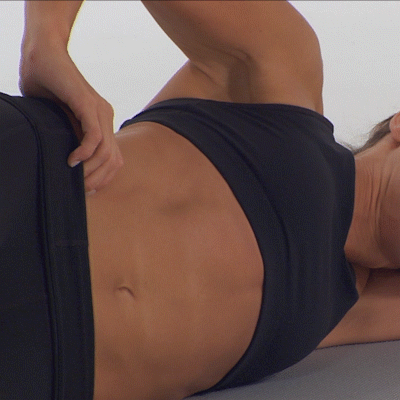
TRANSVERSE ABDOMINIS SIDE BRACING
Setup: Begin lying on your side with your knees bent, feet resting on the floor, and the fingers of your top hand resting on your stomach — just inside your hip bone.
Tighten your abdominals, drawing your belly button in towards your spine. You should feel your muscle contract under your fingers. Hold this position, then relax and repeat. Breathe. Perform for 30 – 60 seconds.
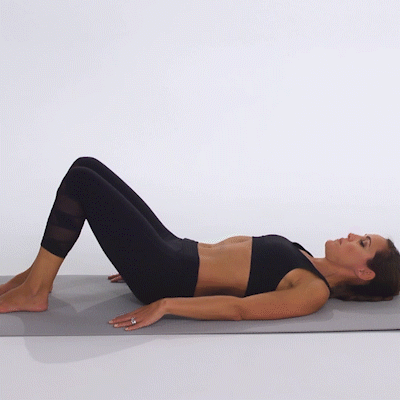
BENT KNEE FALLOUTS
Setup: Lie on your back with your knees bent and feet resting flat on the floor.
Tighten your abdominals. Without letting your hip bones move, slowly lower one knee out towards the floor – only as far as you can without your pelvis moving. Slowly return to starting position. Alternate with other leg, repeat. Brace your core so your pelvis is stationary. Perform for 30 – 60 seconds.
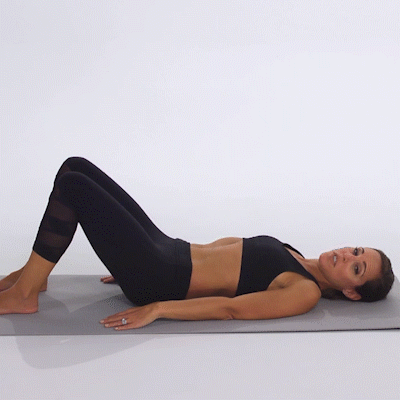
ROLLING BRIDGE
Setup: Begin lying on your back with both legs bent and your feet resting on the ground.
Tighten your abdominals. This will engage your deep core muscles to lift your hips off the ground into a bridge, hold. Lower by rolling down one vertebrae at a time, then repeat. Your body should be in a straight line at the top of the movement. Keep your hips level throughout the exercise. Perform for 30 – 60 seconds.
As much as we want to focus on the core, your body also needs cardio, flexibility/mobility, and full body strength exercises. Moms Into Fitness has postpartum workouts in all your favorite formats:
All of these can be found in our Postnatal Program. Please remember to listen to your body, and ease into exercise with a postnatal workout routine only if it can be done pain free.
Although a C-section is major surgery, it’s important to understand what actually happens during the procedure. Contrary to popular belief, the abdominal muscles themselves are not typically cut — they’re separated and moved aside to access the uterus, which is the only muscle surgically incised.
During surgery, a transverse (“bikini cut”) incision is made across the lower abdomen. This technique follows the body’s natural lines and usually results in fewer complications. However, it can lead to a temporary pooch or shelf near the scar as the body heals. With time, proper core training, and gentle scar mobilization, this usually improves significantly.
You might experience numbness around the incision site for months after birth, as nerves regenerate. Exercise progression should be slow and mindful. Avoid lying directly on your belly or doing movements that pull at the incision until you are fully comfortable.
In the early stages, supporting your abdomen with a small pillow can offer extra comfort during movement. Some women find relief from wearing a postpartum support band or belly binder. These can help you feel more secure, but they should be used for short-term comfort only — not as a replacement for rebuilding core strength. No brand of shapewear can “tighten” muscles; healing comes from nature, time, and a smart postpartum exercise plan.
Many women are dismayed to discover a shelf, bulge, pouch, or pooch (all terms I’ve heard from women!) that protrudes over their C-section scar. I experienced this myself. This “shelf” is fatty tissue damage and is prominent because of swelling. Once the parts of my body, inside and out, had settled back into where they belonged, the scar tissue should remain the only evidence of the surgery.
With patience and scar mobilization (more on that below), the bulge will reduce over time.

The image on the left above shows my profile post-operation at one week postpartum, before any scar mobilization or exercise. The image on the right shows me at 10 weeks postpartum after scar mobilization and beginning to exercise again.
A woman who has sustained multiple C-sections will end up with more scar tissue. Whether she chose stitches, staples, or tape for suturing should not make a difference in the amount of fatty tissue damage or scar surface area.
Normal tissue in our bodies is aligned in a nice uniform direction. However, when scar tissue forms, it is kind of like your toddler played pick-up sticks and tossed them all over the floor. The tissue is laid down in haphazard directions. Your C-section scar is no different. The scar tissue can stick to the tissues underneath and to the abdominal muscles.
This scar tissue can cause many more problems beyond cosmetic. When the scar tissue impacts the muscles around it, it can cause issues with the deeper core muscles firing correctly, incontinence, back pain, and pain with sexual intercourse.
Women who have struggled with back and pelvic pain for years are doing everything they can think of to improve their symptoms, and are feeling defeated — only to find out their C-section scar is preventing them from being successful. Let’s work those scars and get them conquered early in the game so you can move on to the fun stuff!
So often I find that moms think that once they have a C-section scar, it is what it is and there is not much they can do about it. There is hope mommas!
Scar tissue responds very well to mobilization. I know … big words … sounds fancy but it is quite easy to do on your own.
First, do not get over eager too early in the game — you can pull open your incision. Wait until your incision is fully healed! Then put your fingers down along the incision and move your incision/scar in every different direction. Start gently. All of this should be fairly pain free. After you can do this with gentle pressure, deepen your pressure. A little soreness is ok, but do not torture yourself! Be patient, it is not going back to normal overnight, regardless if your scar is 4 weeks old or 10 years old.
If you have a thick scar that is super tender and angry, or are dealing with issues with back pain, incontinence, or diastasis recti, please find a physical therapist/physiotherapist who specializes in women’s health/pelvic health. They will be able to address your scar and other issues and get you back to being supermom much more quickly than if you just do a simple scar tissue mobilization at home.
Download the Prenatal & Postnatal Exercise Guide to learn more about the why and how of scar rehabilitation as well as common postpartum conditions like diastasis recti, pelvic floor dysfunction, prolapse, incontinence, and back pain.